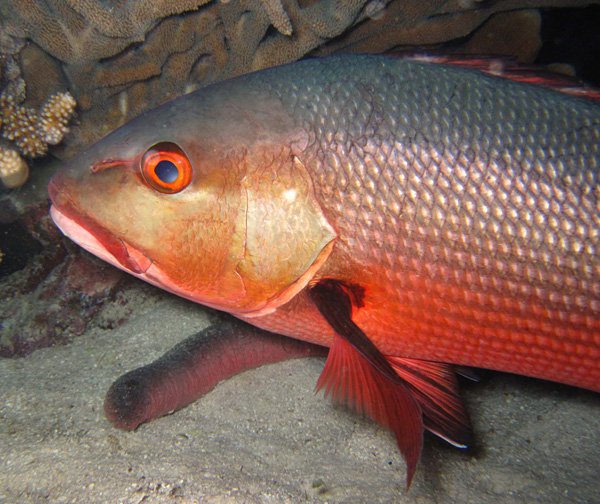Red Bass, Lutjanus bohar (Forsskal, 1775)
Introduction
Adult Red Bass are red with brownish to black shading along the back and usually on the uppermost rays of the pectoral fin. Deep grooves run from the eyes to the nostrils. The species occurs in tropical marine waters of the Indo-Pacific.
Identification
The Red Bass is red with brownish to black shading along the back and usually on the uppermost rays of the pectoral fin. It has deep grooves that run from the eyes to the nostrils.

A Red Bass at a depth of 18m, Cod Hole, Ribbon Reefs, Great Barrier Reef, December 1999.
Image: E. Schlögl© E. Schlögl
Distribution
It occurs widely in tropical marine waters of the Indo-Pacific. In Australia it is known from the central to north-western coast and islands of Western Australia and the northern Great Barrier Reef to southern Queensland.
The map below shows the Australian distribution of the species based on public sightings and specimens in Australian Museums. Source: Atlas of Living Australia.
Feeding and diet
The Red Bass feeds mainly on fishes but will also consume other prey such as crustaceans.
Life history cycle
Research of Marriott and Mapstone (2006) showed that the species is long lived. Up to 56 annual rings were found in otoliths of Red Bass from the Great Barrier Reef, indicating that the species can live at least 56 years.

© John Long
Economic impacts
The Red Bass is an important commercial fish in many areas. In the western Pacific (including Australia), large individuals can potentially cause ciguatera poisoning.
References
- Allen, G.R. 1985. Snappers of the World. An Annotated and Illustrated Catalogue of Lutjanid Species known to Date. FAO Species Catalogue. Vol. 6. FAO. Rome. Pp. 208, Pl. I-XXVII.
- Isbister, G.K. & M.C. Kiernan. 2005. Neurotoxic marine poisoning. The Lancet Neurology. 4(4): 219 - 228.
- Marriott, R.J. & B.D. Mapstone. 2006. Geographic influences on and the accuracy and precision of age estimates for the red bass, Lutjanus bohar (Forsskal 1775): A large tropical reef fish. Fisheries Research. 80 (2-3):322-328.
- Randall, J.E., Allen, G.R. & R.C. Steene. 1997. Fishes of the Great Barrier Reef and Coral Sea. Edition 2. Crawford House Publishing. Pp. 557.


